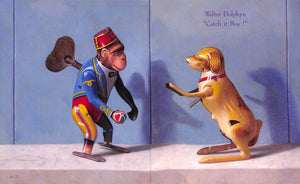"Walter Dolphyn: Catch It Boy!" 2007 (SOLD)
Price on Request $50
[13] pp.
W.H. Patterson Fine Art Dealers
2007
10" x 8"
Stapled wraps
Fine
Scroll Down for (8) Additional Scans:
Born in Antwerp in 1963, Walter Dolphyn grew up in an artistic milieu. His father Willem, grandfather Victor, the esteemed artist and former professor at the Antwerp Royal Academy of Arts, and his great-uncle Denis were all painters, each with their own distinctive styles.
Despite his artistic upbringing, Walter initially decided to pursue a career in the printing trade, which he completed his training for in 1983, after a period of national service. Walter executed a small number of still lifes in 1984 and 1985, but any real artistic intention remained in the distant future. Despite his unmistakable talent, Walter’s early artistic achievements were limited to a number of drawings and illustrations for birth announcements, wedding cards and advertisements. After five unsuccessful attempts to take classes in drawing and painting at the Academy of Berchem in Antwerp, Walter continued to work in the printing trade for six years, first with the Antwerp provincial authorities and then with a banking firm. Here, he exhibited a series of drawings depicting houses with dilapidated facades, which he had made during working hours and in-between printing assignments.
In 1992, Walter decided to give up his career in the printing trade and follow in his father and grandfathers’ footsteps. The nucleus for this was a request by a friend of the family, Willy de Quidt, to design a CD cover for his latest music project, a house music version of Frere Jacques by a line up called “So What”. His father Willem, never one to shy away from a challenge, had agreed to do lead vocals on the single. To everybody’s amazement Walter disappeared behind his easel and painted a portrait of a futuristic Techno monk standing in front of an intricately detailed brick wall. Not only was this CD cover EMI Belgium's finest of 1992, it also rapidly became a collectors’ item. It was during this time that Victor’s health was deteriorating, and following the success of the CD cover, Walter promised his ailing grandfather that he would try to become a successful painter in his own right.
In the early years of Walter’s artistic career, apprenticed in his father’s studio, most of Walter’s intricately detailed paintings pictured run-down facades and doorways, much like his earlier drawings. Walter felt the burden of Willem and Victor’s reputation of technical excellence and as a Dolphyn would carefully depict every minute detail of his subjects, to great effect. Gradually, Walter’s technique evolved towards trompe l'oeil, with compositions featuring cabinets and shelves filled to the brim with objects weathered and worn by time, especially old toys.
Where Willem would painstakingly depict still lifes of succulent fruit and priceless ceramics that he obsessively collected in his Antwerp studio, Walter’s focus moved to his favoured collectable items: toys, figurines, gadgets and miniatures, all vividly rendered with exquisite painterly precision. Classical technical virtuosity along with a shared aesthetic of luxuriant colour and attention to detail provide a rich link between father and son’s work, and denote the common artistic heritage passed from Willem’s father and Walter’s grandfather, Victor.
The art of narrative is at the heart of Walter’s practice. Jokingly self-styled as the Hieronymous Bosch of his age, above all Walter aims to tell stories. Inspired by the toys or figures themselves or by an everyday observation, he then directs the protagonists, sometimes solitary, sometimes in various surreal combinations, often poised mid-action, or crowded into vitrines and onto shelves. This storytelling impulse again taps into a family legacy, this time from Walter’s great grandfather, a famed writer with texts now translated into fifty-six different languages. Each composition includes something relating to the artists own life and those viewers looking closely will be rewarded with a personal angle to each work.
Further elaborations to the narrative in his work include a new format inspired by comic books, in which a larger canvas of a main composition is matched with a smaller ‘what happened next’ canvas. Walter’s paintings invoke wonder, because, apart from the technique applied, they have little in common with the familiar genre of still life. The objects are assembled and arranged with such painstaking precision that a tangible tension is created that rests on a healthy dose of subtle humour. Many works tell a brief pithy joke or a compendium of tales untold, about which we are invited to speculate.
As lighthearted as his subject matter might first appear, Walter’s technique remains faithfully classical. Working from his studio in France and taking advantage of the wonderful Northern European light, his process is to first make sketches, followed by an initial underpainting of diluted oil, before working the objects out in full one by one. Achieving such exacting levels of detail is so demanding that he can only work in fifteen-to-twenty-minute bursts on certain compositions, providing for a limited output of the highest standard.
Walter has exhibited widely both in Belgium and abroad. W. H. Patterson regularly exhibited joint exhibitions of Willem and Walter Dolphyn’s paintings in Mayfair from 2000 to 2012. Upon moving to the gallery’s current location on Beauchamp Place, the immensely successful “On Top of the World” Exhibition of Walter’s work was held in 2014. Walter’s work never fails to capture the imagination and it is for this reason that he remains such an influential and unique artist to this day.

















